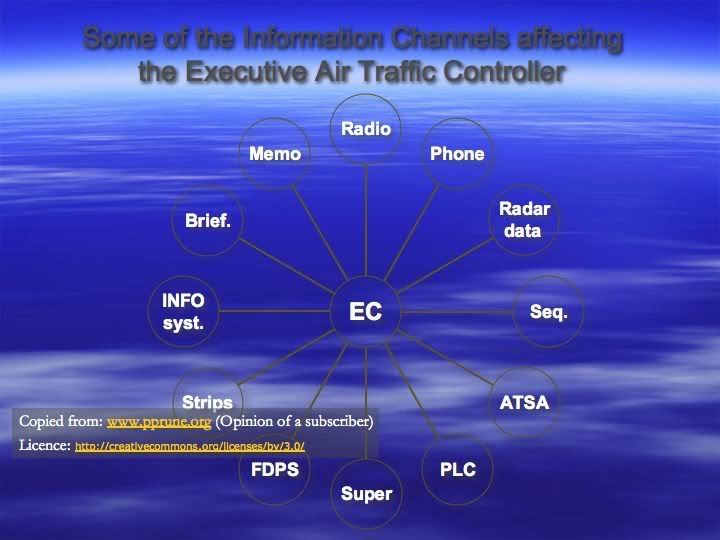OK, friends. The next picture for all of us.
You are free to comment.
On this picture is a representation of almost all of the
information channels of the EC. The Executive Controller (EC)
gathers the information to make sound judgement
of the situations and circumstances from these channels.
These are the crucial information
the EC utilizes to make her/his decisions.
The point here is that all of these affect the safety one way or another.

Explanatory material:
Phone=Voice communication system direct telephone lines.
Radar data=All the data that the radar terminal provides.
Seq.=Sequencing information. Information provided by a computer about the order
on which the traffic should optimally be sequenced to the holding point or the FAF
etc. (FAF=Final approach fix).This information can be provided also by the planning controller.
ATSA=The information provided by the Air Traffic Services Assistant.
PLC=All the information and interaction with the Planning Controller (If any).
Super=All the information from the shift SUPERvisor
FDPS=Flight Data Processing System. Automated system for handling the flight plan information.
Strips= Information from printed paper strips or hand written notes. Can be printed on the radar screen
INFO Syst.= Auxiliary information systems. (Weather data, Airport info etc...)
Brief.=All the information presented on a shift briefing. (Weather, specials etc...)
Memo= All the data that is available to the ATCO from her/his short term and long term memory.
Some of the other possible information channels include:
COR=Coordinating controller
APP=Approach controller
ARR=Arrivals controller
DEP=Departure controller
TWR=All the tower controllers
All of the above are usually accesible with direct telephone lines. Sometimes
they are situated in the same operations room to ease the direct
communication, coordination procedures and supervising.
More common information channels in the ATC include the following:
STENT=Stentophone or equivalent. Direct voice channel from working
position to another. Sometimes verbal communication happens directly
between positions without any electronic equipment. In some ATSU:s
(Air Traffic Services Units) it is recorded, for safety.
OLDI=On Line Data Interchange. Semi-automatic interchange of the flight Data
between adjacent sectors or ACC:s (Area Control Centre=Centre)
OPS Room=All the noices and voices in the background of an Operations Room.
This can provide crucial information, e.g. if a sector is dealing with an out of the ordinary situation.